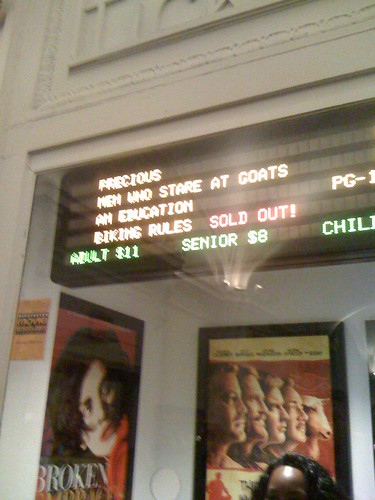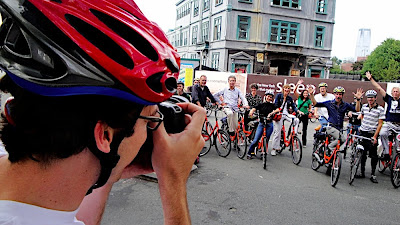This is a little rumination I've been sorting out, so apologies upfront for the rudimentary nature. If I've been workshopping in my head, BttN seems to be a good spot to lay everything down and geek out.
I've been spending some time thinking about the multitude of ways planners can contribute to change; learning about the situation in Haiti has made it more immediate. (To be honest, I was also inspired by the Bauhaus exhibit at MoMA where examples abound of workshopping and testing the flex of combining multiple disciplines to contribute to society.) Other professions have figured out a succinct and valuable way to apply the skills of their profession for public service. Examples of those groups include Medicins sans Frontieres/Doctors Without Borders, Union of Concerned Scientists and Architecture for Humanity. There are myriad smaller organizations that do similar work: engineers working on eradicating TB, architects working on affordable, community-based sustainability, for example. All of these groups are emblematic of specific knowledge and skills applied to a specific situation. Sometimes the need is much more immediate, as in Haiti. Other times, it's a longer-term need. Doctors may be the only profession with a common oath; however, it seems that the creation of the organizations is an implicit recognition that many other professions also have distinct power through their specific knowledge to save lives and make people's lives better.
What would a so-called Planning Corp do? Sorting through this brings up more questions than answers. Fundamentally, what do planners do? They help make decisions about how the built environment will be formed, how the natural and built environments will relate to one another, and all with the goal of making people's lives better. Planners collect data, and conduct research and analysis against an understanding of space. How does planning happen? Through a series of decisions, sometimes through an established public process or a private development process, usually a combination of both. How do those decisions get made? What's required to make them? Yikes. The arc of planning always seems long-term; what do planners have to offer in the short-term?
(In disaster situations, there must be (hopefully?!) a typology of responses that has been established among relief agencies. The process of response also carries with it a geo-political context. For example, without knowing the particulars, the decision to cede control of the airport to the U.S. seems loaded. Who gets to go into Haiti - what groups? Who receives access to resources to set up and has legitimacy to be there? Who decides?)
Planners often get lumped with architects and designs. A quick look through the Architecture for Humanity opportunities list shows that the focus on the building facility first; the design process proceeds from that starting point. Architects probably take on a huge amount of the planning responsibilities too, but it's hard to know where that starts and ends. There's Architects, Planners and Designers for Social Responsibility too; role? It would be interesting to follow-up with folks who worked on the Katrina reconstruction and see what lessons and best practices could be found.
I think it's dawned on everyone that the practice of planning needs to extend beyond the effort of making the planning process more inclusionary - or maybe the definition of inclusion needs to be expanded. Though that aspect of planning is absolutely necessary, planning as a discipline seems to have to make a bigger change than just getting community input per se.
Outside of physical design, planners also deal with a lot of data - from how it's defined to how it is collected to how it is communicated. I've become more and more curious about open data and the politicalization of analysis and access, thanks to the nudging of a couple of good folks in NYC. I guess it's about time! In this vein, the CrisisCamp response to the Haiti situation seems extremely appropriate and efficient. The application of data across space is very much an exercise in planning - but participation seems very much defined by computer program developers, not planners (the CrisisCamp folks made a great effort to include a role of non-techies in the projects).
Mobile app developers working on Creole/English tool at Haiti CrisisCamp DC
So I'll put it out there: what do you think a Planning Corp would do? If planners had to band together to respond to crisis, to injustice, to social change, in the long-term and short-term, what would they bring to the world? Sometimes I try something more specific: what would the Hippocratic Oath be for planners? And finally, what's missing here?
1.18.2010
In public service
Posted by Shin-pei at 12:51 PM 2 comments
1.13.2010
Grand Army Plaza - book release!

The fine folks at Design Trust for Public Space have released the book (free download available) on the Reinventing Grand Army Plaza design competition. The book looks wonderful - they always kick out stellar publications, those people.
If you'd like to get involved with the ongoing improvements at Grand Amy Plaza, there are a lot of opportunities through GAPco, the community-based coalition led by residents, business owners, elected officials, and among them, quite a few folks who are experts in public space and transportation. The first meeting is coming up soon...check the web site for updates.
This is a great example of organizing, coalition building, ideas design competition - all leading to physical changes in this space.
Posted by Shin-pei at 12:17 AM 0 comments
1.11.2010
For the love of bikes
Recent industrial design Pratt grad Vanessa Marie Robinson has a few great ideas to make biking easier, safer and much more stylish up on her awesome blog, for the love of bikes.
A cool bike bag with expandable helmet area...
Reflective riding gloves that don't scream spandex warrior...
A bicycle tool utility bench for our tiny NYC apartments...

Posted by Shin-pei at 6:10 PM 0 comments
1.08.2010
New old news

source
Britta/Window Farms reached its fundraising goal!
Another discussion about defining blight...
Posted by Shin-pei at 6:15 PM 0 comments
What is Affordable Housing?

Center for Urban Pedagogy only gets better and better. It launched this new project, Envisioning Development, that investigates first, "What is Affordable Housing?" Awesome!! Check out the map. Looks like Zoning and ULURP are next in line...
From CUP:
Our work grows from a belief that the power of imagination is central to the practice of democracy, and that the work of governing must engage the dreams and visions of citizens. CUP believes in the legibility of the world around us. What can we learn by investigation? By learning how to investigate, we train ourselves to change what we see.Yes, yes, yes, and yes!
Posted by Shin-pei at 1:41 PM 0 comments
1.07.2010
Modern Shipwrecks
"My belief is that uncertainty brings about a heightened awareness of place." - Marie Lorenz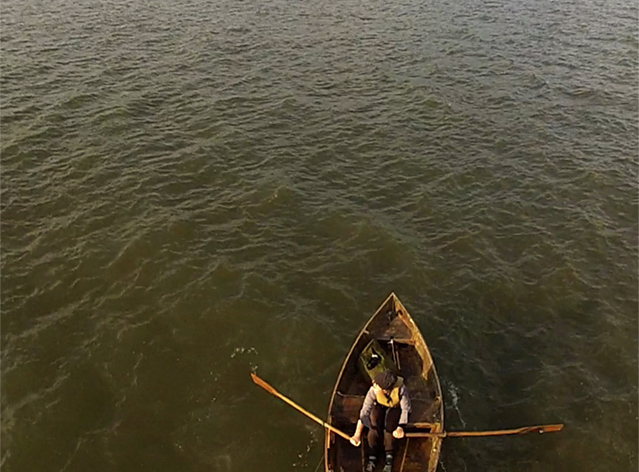
Anyone who's traveled to a different country knows how much this rings true. I heard Marie Lorenz's talk at the Gel conference back in 2007; she was one of the more memorable speakers. I love her deep commitment to the basic theme, which is a simple idea - build boat, explore shoreline - with the experiences extremely unpredictable. Her execution is impeccable. Simple ideas really are the most brilliant. 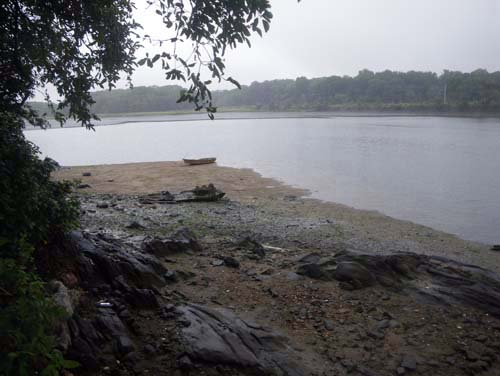
Read her statement and go through the many trips (and maybe one shipwreck) she has taken on the shorelines of New York City. You can view her most recent shipwreck at her opening tomorrow night, January 8, at 6 PM at the Jack Hanley gallery.
Posted by Shin-pei at 8:39 AM 0 comments
1.05.2010
Narrow streets experiments
One can always dream...

westwood boulevard + pico boulevard, west los angeles
...fun to check out.
Posted by Shin-pei at 7:10 PM 0 comments
Looking for good people
Transportation Alternatives is looking for a few good people to intern and hire.
Posted by Shin-pei at 6:37 PM 0 comments
12.29.2009
Down to (vendy) business
A message from Sean Basinski, Director of the Street Vendor Project:
A couple weeks ago at a holiday party, I heard someone describe the Street Vendor Project as "that group who puts on the Vendy Awards."Read more about Mohammed and a request for micro-lending.
I was impressed that he knew about our big yearly event, which continues to thrive and grow. But I was frustrated that the Vendys had again overshadowed the work we do at SVP every day, organizing and advocating for hundreds of vendors who will never receive an award but deserve our recognition and assistance just the same.
One of those vendors is Mohammed Ullah, and immigrant from Bangladesh who sells roasted peanuts near Times Square. With no vending permits available, Mohammed can´t open his own business - the cart he works belongs to his boss, who pays him $60 to $70 a day. He lives in a small apartment in Brooklyn with his family.
Posted by Shin-pei at 5:46 PM 0 comments
12.24.2009
Another one
Am finding endless awesomeness this week (in spite of the wack).
Yay for Candy Chang. Her projects are amazing and the process really illuminating...connecting a design product to advocacy. Yay! Thanks Urban Omnibus for pointing her out again.


(I'm a softy for the Street Vendor Project too. This year's at the Queens Museum was worth the trek.)
Posted by Shin-pei at 9:36 AM 0 comments
12.23.2009
Scattered Light

ASDF designed six posters.
One poster will be released a month.
Each poster has a photo by David Horvitz on one side and a text on the other. Together, the photo and text present various themes relating to the concept of space/place/surroundings.
Each poster release serves as an open call for photographic responses. The response should be based on the poster's text and image, along with an “Assignment”. The “Assignment” is announced with the poster release / open call. These open calls are open to everyone who wishes to participate.
Assignment 1
Posted by Shin-pei at 10:58 PM 0 comments
WTF - Copenhagen Climate Talks
Read this last night, listened to this just now (check back tomorrow for today's program). Speechless.
Posted by Shin-pei at 9:41 AM 0 comments
Opening up process with open (specific) data

I visited DC a couple weeks ago and hung out with my close friend/doppelganger who works at the National Democratic Institute (NDI). She seems to have no end of interesting projects, but one of her latest, mapping voter data from Afghanistan's November 7 elections, in partnership with DevelopmentSeed, is really amazing. You can play around with some of the results at Afghanistanelectiondata.org.
The issues barring democratic civic engagement in Afghanistan are obviously different than the ones that we face in the US. I think the lesson here is that you have to identify data collection/visualization with a heavy dose of political strategy that's connected to influencing the change you want to see. She and I bandied this around a bit; she's a master at political strategy and can talk you through/out of anything you might think is a brilliant idea (<3 her!)
OK, duh I know, but how many times has data been collected/analyzed/visualized to look cool but still doesn't seem to say very much or remains disconnected to advocating for change? For example, I'm looking at the viability of inserting health impact assessments (HIA) into the planning process for local development projects. Yes, conceptually it totally makes sense. But when you drill down, identifying the most valuable public health indicators becomes really hard. Plus, what difference would a HIA make in NYC's ULURP or CEQR process without advocating for changes in those outdated processes as well?
It doesn't matter how big or small the project is; identifying the specific data needed to create the change in the specific political/cultural context is absolutely necessary. Sometimes simple is good, or the best. Getting to simple specifics is the hardest part of the thought process.
(Whoo-hoo, congrats cc!)
Posted by Shin-pei at 7:53 AM 0 comments
12.20.2009
Green It Yourself
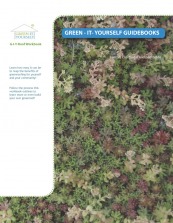
My partner in the Grand Army Plaza design competition, Lori Gibbs, and the talented Atom Cianfarani, just finished another project that promotes local sustainability - a DIY workshop book on green roofs, part of their Green It Yourself series. They break down the process and language of this kind of project and give you lots of pointers on what is absolutely necessary and what can be more flexible as you design your greenroof. The greenroof workbook is available now; they'll sell green roof supplies on the same site soon. Congrats!
Posted by Shin-pei at 10:41 AM 0 comments
12.18.2009
Kickstart Window Farms
A note from Window Farms:
We are making a big leap and turning The Windowfarms Project into a NON-PROFIT WEB STARTUP dedicated to grassroots R&D on food growing in apartments! We are writing to all of you to ask for your support during our online fund-raising drive. We have until 2pm EST on Jan 4th, 2010 to raise $25K, and we're more than half way there -- please contribute!
Britta Riley started The Windowfarms Project as a grassroots way to start to address issues concerning our food system, and to give ordinary people a way of participating in the "green revolution." Over the last year, through an organized online collaboration of regular folks, we "Windowfarmers" have designed a system for growing nutritious veggies in the windows of homes in a way that looks like an elegant garden/fountain. We have given away the plans and shown anyone how to make them out of cheap, easily accessible and recycled materials. Windowfarmers are continuously testing new techniques and sharing results online to make Windowfarms more efficient, more productive, more nutritious, quieter, prettier, and more tasty.
The project has been exceedingly popular (worldwide, even!)-- so much so that it has grown past Britta's capacity to manage it and financially support the work to be done. It needs to become an organization and have its own patrons until the grants we have applied for (surely!) roll in late next year. Together with Maya Nayak, Britta is attempting to turn it into a nonprofit dedicated to the open research and development of Windowfarms for our homes! We are applying for 501(c)(3) status, and have a 3 member Board.
Posted by Shin-pei at 1:18 PM 0 comments
12.16.2009
"Monkeying around" with what you've got...
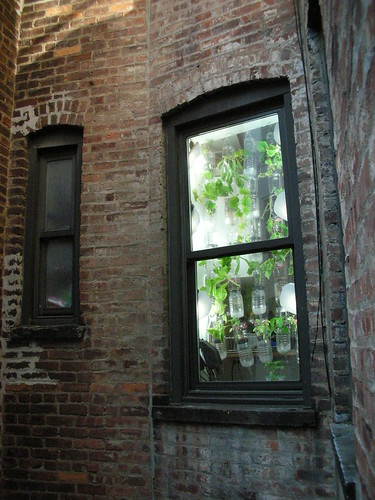
...it might lead to something good!
The night I was over at Eyebeam working on the Buckminster Fuller competition with some cool folks from the New Amsterdam Bike Slam, I was psyched to get a mini-tour from Britta Riley about her hydroponic window farming system, designed specifically for urban dwellers who have no access to dirt or horizontal space but may have a window available. You can read an interview with her here; I love that she says "monkey around" a couple of times. A Window Farms kit is in the works, I think.
Posted by Shin-pei at 12:47 PM 0 comments
12.15.2009
NYC BigApps
Kinda love this competition and the many applications that came out of it. As with many of these types of things, you can see the high potential of pairing technology, information and space; but you also experience many limitations of existing data and our definitions of space. The decisions that get made along the way - whether because of individual biases, data restrictions, existing systems, etc - do have a big influence on what can be served up.
(Course I'm always behind on this stuff...this isn't news.)
Posted by Shin-pei at 4:30 PM 0 comments
12.09.2009
Bikes in Buildings
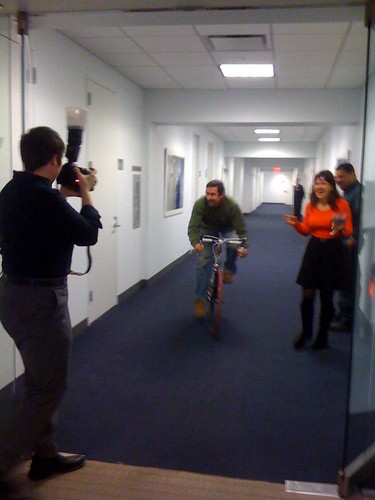
The look of pure glee! This guy, the official photographer of T.A.'s Bikes in Buildings event at WTC 7 last night, won the raffle and took off down the hall on his new bike. The security guys didn't even give him a second glance: another definition of bikes in buildings.
Posted by Shin-pei at 11:04 AM 0 comments
12.08.2009
Watersquares

via Pruned
My head is filled with process these days; a part of the practice of urban planning that is somewhat opaque and difficult to show others. So I was keen to find out about this Watersquares project (pdf) in Rotterdam; a cool example of how something moves from:
problem --> design concept --> research and dev --> urban planning --> urban policy
The problem of stormwater management and an overtaxed sewage system led to a potential design solution that was then prototyped and developed, put through the applied planning wringer, and emerged as viable urban policy for the City of Rotterdam. And, to make it completely accessible to those who never come in contact with the wonkiness of "urban stormwater management" it looks like a graphic novel is coming out to explain how it works. The work is by Florian Boer and Marco Vermeulen (friend of yours v?) This project sounds awesome.
Posted by Shin-pei at 1:59 PM 0 comments
12.07.2009
Office of Urban Affairs

Fascinating story about the Office of Urban Affairs's agenda by WNYC's Andrea Bernstein.
Posted by Shin-pei at 8:21 AM 0 comments
12.04.2009
Defining blight?
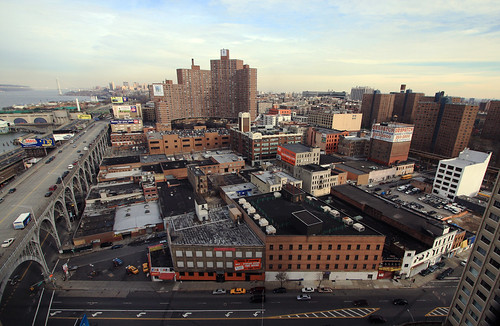
How do big organizations who can issue bonds to fund development projects on land that is seized through eminent domain define "blight"?
Hopefully this Columbia University court decision will make more people question the certitude of these projects.
Posted by Shin-pei at 12:43 PM 0 comments
12.01.2009
Hard at work
Bedford Avenue is one of the longest streets in New York City, running nearly the full length of Brooklyn. It's a vital corridor that handles a lot of traffic of all kinds (many many peds, bikes, cars, buses, and trucks) and is truly representative of the different neighborhoods through which it travels.
So it was particularly saddening to see this happening, this morning...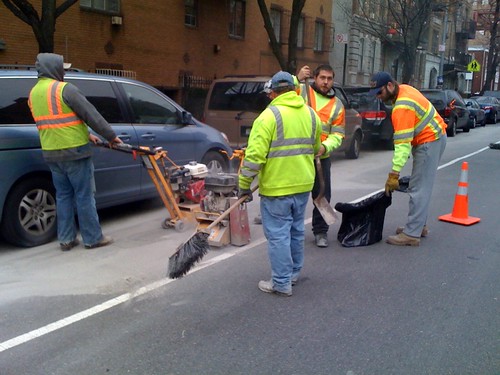

It's pretty clear once you get past Flushing where the bike icons have been removed that, as a cyclist, you are not welcome here. So sad, I love Bedford Avenue for its vibrancy, especially in this part of the city. It's hard to be made unwelcome in a neighborhood you like.
(Thanks CS for the images!)
Posted by Shin-pei at 5:33 PM 1 comments
11.29.2009
Looking up
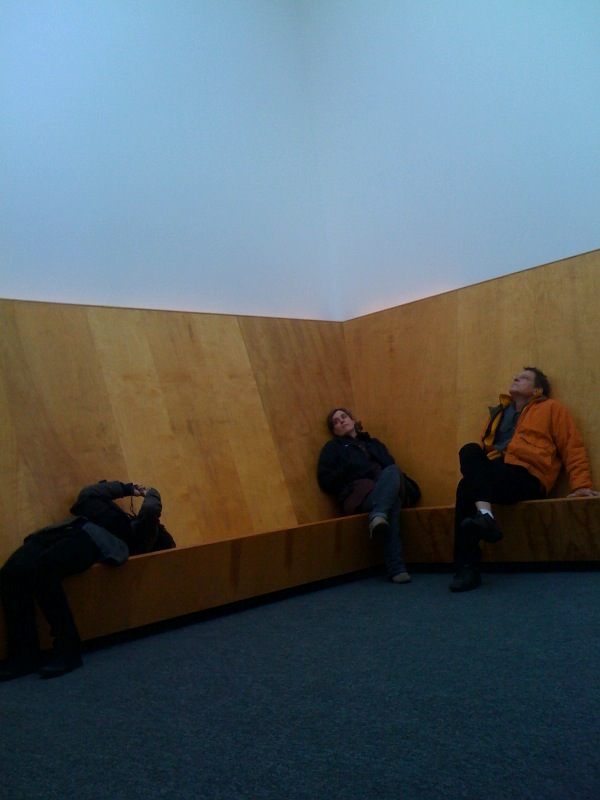



My favorite thing at PS1 is James Turrell's Meeting, for the feeling of the sky on your face and for seeing everyone alter their behavior as soon as they enter the room.
Posted by Shin-pei at 9:11 AM 0 comments
11.28.2009
11.17.2009
Local coalition vows to fight for living wage with Kingsbridge Armory Development

"The strong local opposition comes as something of a surprise."
Why? Many members of the coalition originally fought for development of Kingsbridge Armory but will abandon support of the project if it doesn't come with a living wage. It's sad that a living wage in New York City is NOT market wage.
"...a pledge to pay more than the market rate would be a death sentence for the project," says a developers spokesman.
Those who play by market rules have obviously figured out how to build big box in New York City. The jobs are welcome at first; the amenities as well. City Planning approves it as a development opportunity, hoping to spur on local business. But then you find out the jobs don't pay a living wage. As the community lives with the unveiled development, it starts to feel the negative impacts of having the development in their neighborhoods: increased traffic, diminished pedestrian experience, a shriveled public life. We're only beginning to learn how to track the physical impacts of such incongruous buildings.
First Gateway Center in the South Bronx. Then East Harlem Plaza. I hope that the Bronx community sticks to its guns on the Kingsbridge project. After the greenlight from the City, the marketplace players can forget all the promises they've made.
Posted by Shin-pei at 8:11 AM 0 comments
11.01.2009
After the NYC Marathon...
....let the dancing begin! Lafayette St in Fort Greene was a scene out of movie. After cheering for a couple of hours, it was great to see the party continue with people enjoying the street.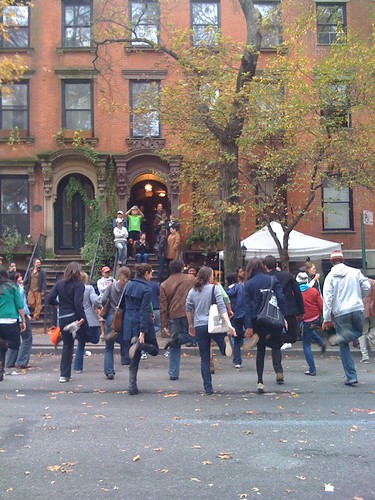
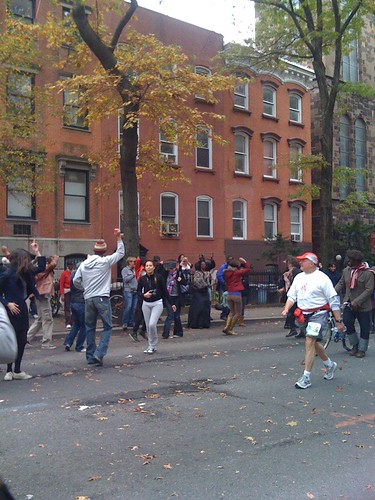
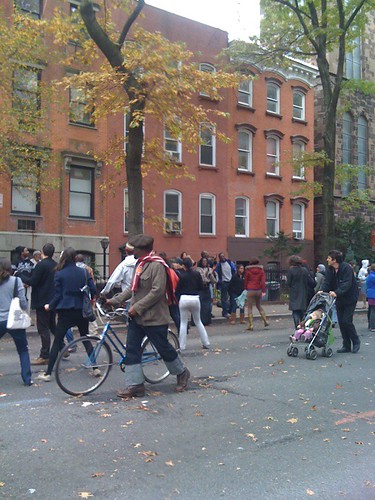
Posted by Shin-pei at 2:36 PM 0 comments
Mapping Main Streets

Image from National Trust for Historic Preservation
A pretty cool project, Mapping Main Street kind of like a StoryCorp with a focus on literal Main Streets.
The goal is to document every street names Main in the country by going to each of these 10,466 places, taking a photo, recording a video or writing a brief story.
Posted by Shin-pei at 2:18 PM 0 comments
10.26.2009
Another way to take back the streets

Before
After
Public Ad Campaign
Posted by Shin-pei at 7:51 PM 0 comments
10.24.2009
10.18.2009
What would you do with a city?
LOVE this exhibit idea...
Just paint, a couple of hoops and voila, rooftop field. (Especially love the forbidding goalies in the form of lamp posts.) From Call to Action, currently at the Graham Foundation in Chicago...
Actions: What You Can Do With the City presents 99 actions that instigate positive change in contemporary cities around the world. Seemingly common activities such as walking, playing, recycling, and gardening are pushed beyond their usual definition by the international architects, artists, and collectives featured in the exhibition. Their experimental interactions with the urban environment show the potential influence personal involvement can have in shaping the city, and challenge fellow residents to participate.Give it a try!
{Thx e!}
Posted by Shin-pei at 10:14 PM 0 comments
Urban Utopias!

Aerialscape by Michael Sherman
I'll be on the panel next Sunday...
"Utopian" Urban Planning
Artists and Community Leaders Discuss Brooklyn's Future
Sunday, October 25, 2009, 2-4pm, Brooklyn Historical Society
128 Pierrepont Street, Brooklyn, NY 11201, First Floor Community Gallery and basement conference room
Admission: FREE
What does it take to build affordable and sustainable living, working, and transportation systems in Brooklyn? How can we develop Brooklyn responsibly to meet the needs of its diverse communities, including its artistic communities? And finally, how do artists play a role in this urban planning process?
At this round table event, Brooklyn Utopias? artists and curator will debate their ideas with community leaders, architects and urban planners, and the general public, with a focus on large-scale planning initiatives. Special guest speakers include Amy Sananman, Executive Director/Founder, Groundswell Community Mural Project, Shin-pei Tsay, Deputy Director of Transportation Alternatives, Derek Denckla, Founder, Propeller Group and Alexander Gorlin, FAIA, Principal/Founder of Alexander Gorlin Architects. The event will feature an exhibit walk-through with artists and curators, followed by a panel discussion moderated by urban historian and licensed architect Marta Gutman, PhD.
"Utopian" Urban Planning is part of the Brooklyn Utopias? exhibitions and public programs series, in which artists and youth respond to differing visions of an ideal Brooklyn. The main Brooklyn Utopias? art show will be on view in the Brooklyn Historical Society's Community Gallery through January 3, 2010.
Posted by Shin-pei at 9:57 PM 0 comments
10.04.2009
Out and about
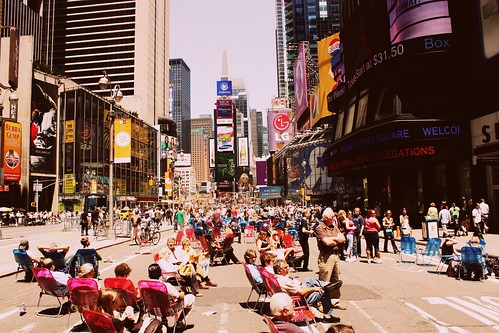
from Flickr
It's a full week in the NYC public space sphere.
Monday night, go to the second of the DOT's public input sessions on Broadway, including the pedestrian islands and bike lanes that run from Columbus Circle to 23rd Street and the "Greenlight for Midtown" project (aka, the coolest, most innovative public realm change this year). For those who tell me they are too busy to click through to event details here they are: Broadway Public Feedback Session, 6-8PM, New Yorker Hotel, 481 8th Ave at 34th Street. Seriously, if you like this project at all, please come out and say so. Public meetings have a tendency to attract the "no's" so if you're more of a "yes", please come out. I know that people want to pick apart the dots, the lanes, the chairs, and every other little thing, so if you're so inclined, you should first read this article by Michael Beirut and then go back to Times Square, stand on Broaday and simply enjoy watching people fill in all the space that used to go to cars.
Tuesday night is the opening night for the international conference on pedestrians, Walk 21. There's loads of great sessions at the conference which runs from Wednesday to Friday this week.
It's Architecture Week too, and for those who can't afford the Heritage Ball, the AIA NY's annual benefit ball on Thursday, the Center for Architecture throws an awesome after party with a more palatable admission.
Hope to see some of you out there this week!
Posted by Shin-pei at 6:44 PM 0 comments
10.03.2009
Who says Block Party season is over?
One of the pleasures of living in New York City is that you'll stumble on out-of-the-ordinary events while on your mundane every day routine. This is what Cybill and I came upon on our way back from the dog run.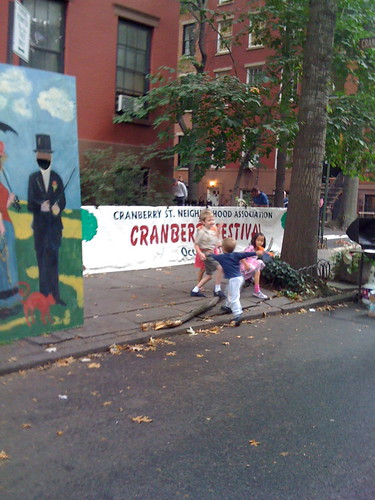
The Cranberry Street Festival!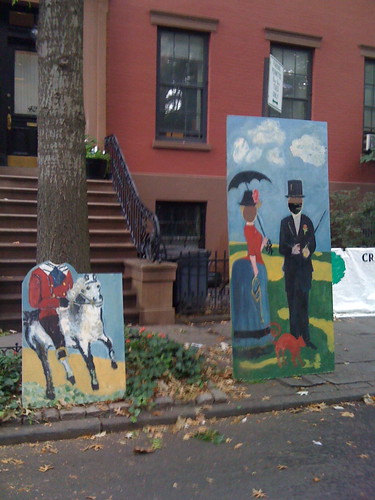
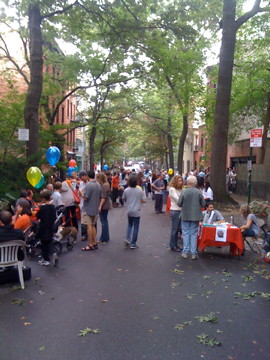
And then on my way to look at refrigerators (the most mundane of all errands) there was the Dean Street Block Party.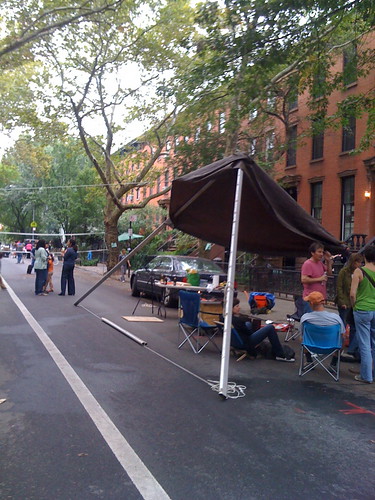
How many types of alternative transportation can you spot in the photo below?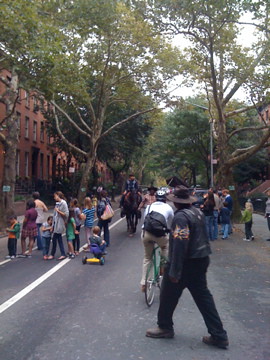
Summer might be over, but block parties live on! (horrible quality, I know, still figuring this out...)
UPDATE: On my way to Windsor Terrace late Saturday night, Dean Street Block Party was still happenin'...a screen had been set up for movie watching. A beautiful way to spend the evening.
Posted by Shin-pei at 4:30 PM 0 comments
9.27.2009
Biking Rules and Peds
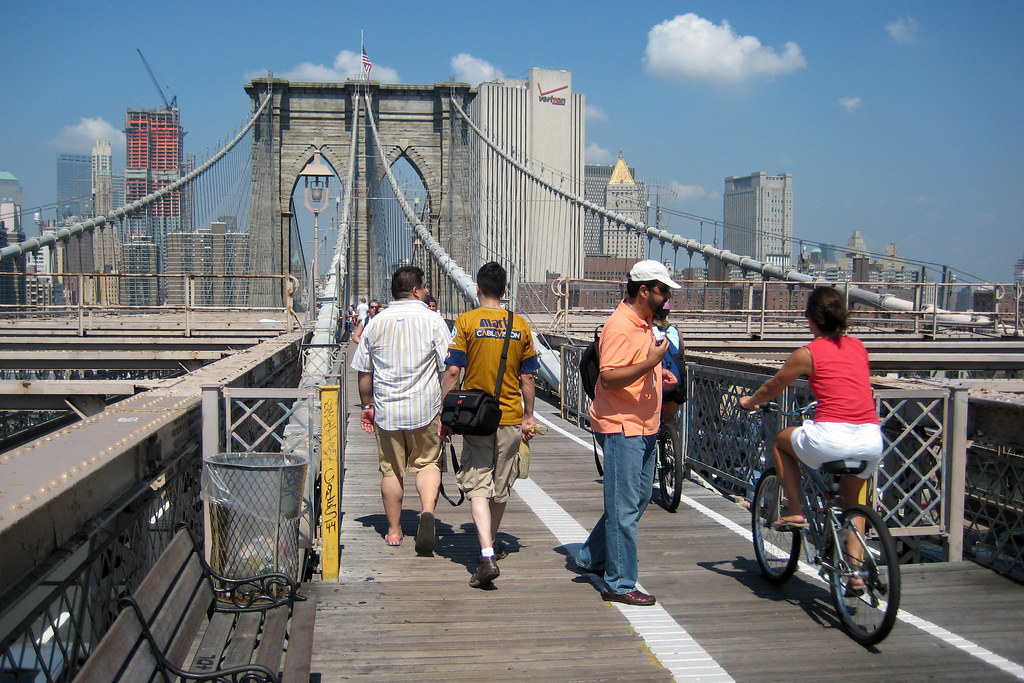
by bluhmr on Flickr
Great article by the prolific Robert Sullivan (he's got two articles in this month's Vogue too, interesting...)about heightened bike and pedestrian conflicts as more and more people take to their feet to get themselves around. Hooray for more people, boo for still not enough space. Yes to a physically protected bike lane on the Brooklyn Bridge roadways to alleviate the congestion on the bike/ped path.
Speaking of which, maybe this article will inspire folks to enter the Biking Rules PSA (i.e., Public Service Announcement) Competition ending this Tuesday. You can win up to $4,000 in cash, and will be eligible for the Biking Rules Film Festival at BAM. What are you waiting for?
Posted by Shin-pei at 12:05 PM 0 comments
Team Amsterdam Wins!
A great NYT description here. We'll be posting the presentations plus photos on New Amsterdam Bike Slam shortly.
Photos here by Pascal van den Noort.
Posted by Shin-pei at 9:45 AM 0 comments
